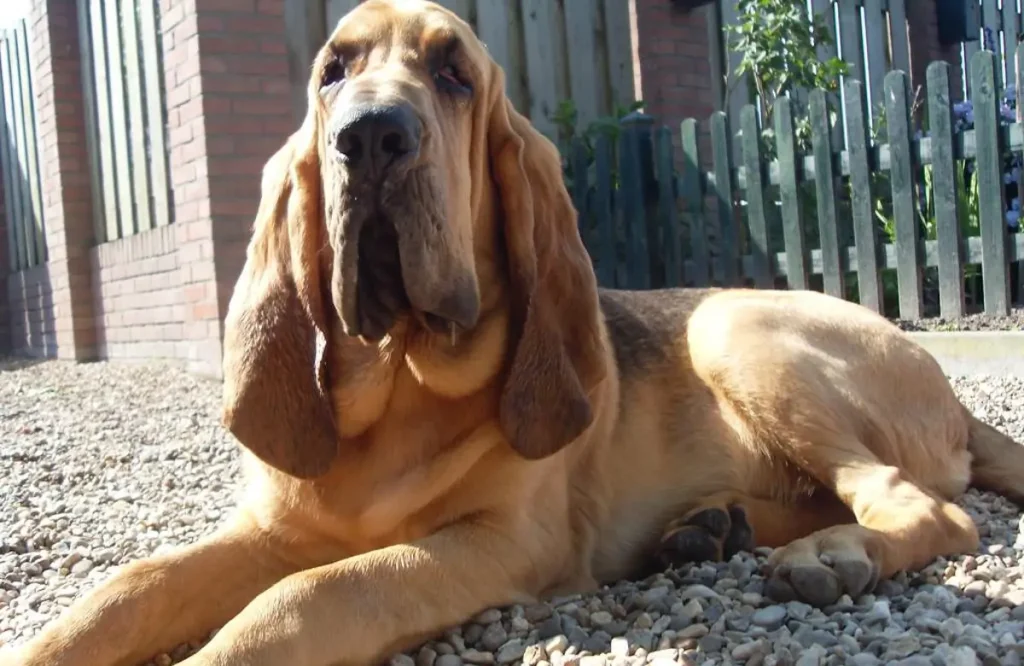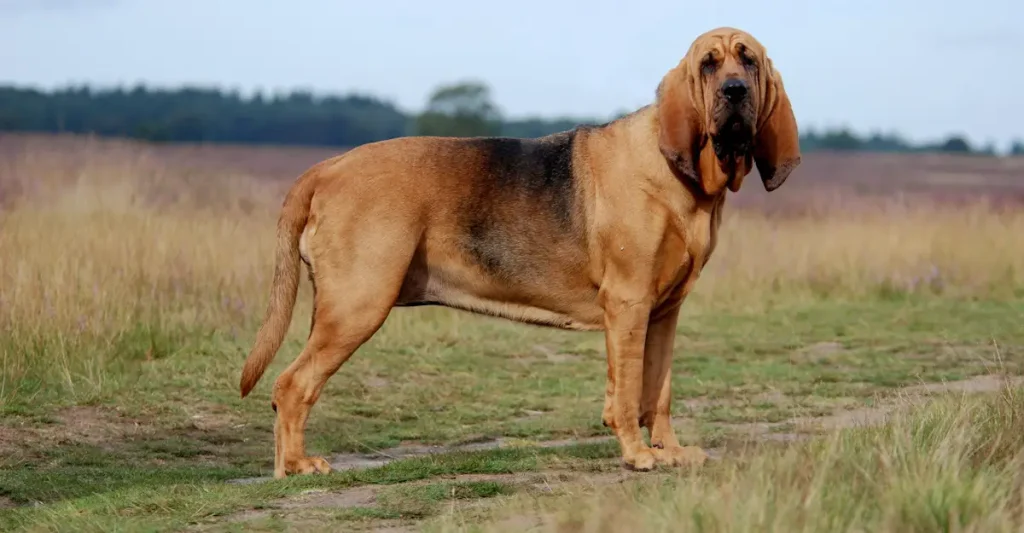Imagine a creature with a nose so powerful that it can unlock the mysteries of a scent trail long after it has faded to the human senses; this is the realm of the Bloodhound, your potential companion in the intricate dance of scent-tracking.
Considering this noble breed’s profile, you’ll find their abilities extend far beyond their legendary noses. Bloodhounds are not just unparalleled trackers; they’re also affectionate family members with a temperament that endears them to children and adults alike.
While not overly demanding, their care does require a specific commitment to meet their physical and mental stimulation needs. Yet, within the folds of their sagacious faces and the deep wells of their devoted eyes lies a story of partnership with humans that spans centuries.
As the keeper of such a storied breed, you’ll wonder about the secrets they can unearth with just a whiff of the air and how their unique traits can complement your life if you’re willing to follow their lead into a world where every scent tells a tale.
- Noise Level
- Energy
- Sociability
- Trainability
- Care
- Health
Overall
Summary
The Bloodhound breed typically rates moderately in noise level, sociability, care, and health, while showing moderate to low energy levels and trainability.
Bloodhound: Traits, Temperament, and Care Guide
The Bloodhound, with its gentle demeanor and an unparalleled sense of smell, requires regular exercise and patient training to thrive in a family environment. Their exceptional scenting ability is enhanced by their loose skin and droopy ears, which trap scents.
Weighing 90-110 lbs and standing 24 inches at the withers, they’re affectionate and mild-mannered. They demand 20-40 minutes of daily exercise for optimal health and well-being.
Exploring the Characteristics of the Bloodhound
Delving into the characteristics of Bloodhounds reveals a breed distinguished by its unparalleled tracking abilities, necessitating a nuanced understanding of their physical and behavioral traits.
| Feature | Description | Importance |
|---|---|---|
| Long Ears | Facilitate scent trapping for enhanced scenting abilities. | Essential for tracking |
| Folds of Skin | Increase scent retention and aid in detailed scent detection. | Critical to function |
| Personality | Gentle and patient, yet independent and self-guided. | Fosters belonging |
Bloodhounds’ long ears and folds of skin are central to their scenting prowess, essential for those seeking a sense of connection through shared endeavor.
Bloodhound: A Comprehensive Profile and Guide
You’ll find that the Bloodhound possesses exceptional olfactory acumen, often exceeding that of other breeds, which is crucial for tracking applications.
Despite common beliefs, their tracking efficacy isn’t innate but rather develops through rigorous training and consistent reinforcement.
Acknowledging these factors, this guide provides an in-depth look at the Bloodhound’s capabilities, care requirements, and how to harness their potential as both working dogs and companions.
Everything You Need to Know
Embarking on a journey to understand Bloodhounds, it’s essential to recognize their unparalleled tracking skills, which play a pivotal role in law enforcement and search-and-rescue operations. Here’s what you need to know:
- Bloodhounds excel in exceptional tracking abilities.
- Some claims about their tracking on various surfaces lack evidence.
- Not all bloodhounds consistently achieve scent discrimination.
- Handling tactics and exaggerated abilities raise safety concerns.

Discovering the Temperament of Bloodhound
When considering the temperament of Bloodhounds, it’s essential to note that these dogs are known for their gentle and patient demeanor, often making them excellent family pets.
Their endearing qualities include a tolerant and affectionate nature, revealed through soulful eyes that reflect a deep-seated expressiveness.
Despite their independent streak, Bloodhounds’ temperament is one of curiosity and liveliness, requiring understanding and patience during training.
Bloodhound: Is It a Good Fit for Families?
You may wonder if Bloodhounds align with the dynamics of a family setting, particularly when children are involved. Their docile temperament coexists well with younger members, while their need for regular exercise complements an active family lifestyle.
However, one must consider their predisposition to ingest foreign objects and the potential difficulty in training, which requires a vigilant and patient approach.
Assessing Bloodhound’s Compatibility with Families and Kids
Although Bloodhounds are known for their gentle and patient demeanor, making them well-suited for family life, their strong-willed nature demands consistent and firm training, particularly in households with young children.
- Gentle with children, fostering a nurturing environment.
- Requires firm training to manage independence.
- Preparedness for their strong-willed decisions is key.
- Extra care needed due to drooling and dietary indiscretions.
Their compatibility with families and kids hinges on understanding these traits.
Bloodhound Adjustability Quirks
Understanding the unique adjustability quirks of Bloodhounds is essential for handlers aiming to harness these dogs’ exceptional tracking abilities effectively.
Their distinct liver and tan coats and long, drooping ears are iconic, but don’t be misled by exaggerated claims.
True proficiency in tracking requires specific training, acknowledging their scent discrimination limits on concrete and from cars.
Dutch research advises reassessment, ensuring your Bloodhound’s capabilities are accurately recognized and utilized.
Bloodhound Training Essentials
As you train your Bloodhound, it’s crucial to focus on developing their natural scenting skills. You’ll need to apply effective training strategies that aren’t solely breed-specific, as individual capabilities can vary.
Be mindful that scent discrimination is a skill that requires targeted training and shouldn’t be assumed as an innate ability of your Bloodhound.
Effective Training Strategies
To maximize your Bloodhound’s innate tracking prowess, it’s essential to integrate scent-focused exercises into their training regimen, employing positive reinforcement to bolster their motivation and performance.
| Training Aspect | Strategy |
|---|---|
| Scenting Ability | Utilize for tracking exercises |
| Positive Reinforcement | Motivate and encourage |
| Drive and Desire | Understand to enhance tracking |
| Exercise and Stimulation | Satisfy natural instincts |
| Independence and Problem-Solving | Accommodate in training methods |
As a Bloodhound owner, you’re part of a community that values effective training strategies for these exceptional tracking dogs.

Exercise and Grooming Needs
Bloodhounds require a well-balanced routine of moderate daily exercise, including regular walks and scent-oriented activities, to maintain their physical and mental well-being. Their exercise and grooming needs are paramount for their tracking abilities.
Weekly brushing controls shedding, while cleaning their droopy ears and skin folds is crucial. Be ready to manage the extra slobber, characteristic of the bloodhound, to ensure their optimal health and comfort.
Health Considerations
As you consider a Bloodhound’s health, there are a few important factors to keep in mind.
Firstly, Bloodhounds are susceptible to gastrointestinal issues like bloat, so close observation is critical to catch any potential problems early on.
Secondly, it’s important to note that their lifespan usually spans 7 to 10 years. As they age, they may require increased attention and potentially different healthcare needs.
Lastly, you’ll need to ensure that your Bloodhound receives a balanced diet and regular activity. Bloodhounds have a propensity for obesity, so it’s important to monitor their weight and provide appropriate exercise to keep them healthy.
Common Health Issues and Lifespan
When considering a Bloodhound as a pet, you should be aware of certain health issues they are predisposed to. These include gastrointestinal problems like bloat, which can be managed by carefully monitoring their food intake to prevent obesity risks. Bloodhounds typically have a lifespan of 7-10 years.
In addition to their predisposition to gastrointestinal issues, it is important to regularly examine their ears, eyes, and skin folds. This will help prevent infections and maintain their overall health and well-being.
It is also crucial to stay vigilant for signs of joint issues or heart conditions. These conditions can affect their quality of life, and early detection and intervention are important for their long-term health.
Is Bloodhound the Right Pet for You?
Considering a Bloodhound as your next pet requires careful evaluation of their high exercise needs and exceptional tracking talents to ensure compatibility with your lifestyle. This breed of dog demands a commitment to provide the Right Food, adequate daily activity, and training to avoid inappropriate eating behaviors.
Ideal for families, the Bloodhound’s gentle nature fosters a sense of belonging, yet its independent streak requires patient understanding.
Alternatives for Bloodhound: Keen and Committed Scent Hounds
Explore these breeds if you appreciate the Bloodhound’s keen tracking ability and commitment, ideal for those who value skilled and persistent scent hounds.
| Similar Dogs | Short Description |
|---|---|
| Basset Hound | Known for its incredible sense of smell and laid-back nature. |
| Beagle | A smaller hound with a keen nose, friendly and curious. |
| Coonhound | Various Coonhound breeds, known for their tracking skills and distinctive bay. |
| Foxhound | English and American varieties, known for stamina and hunting capabilities. |
| Plott Hound | A breed with great tracking ability, used for hunting large game. |
Conclusion
As a Bloodhound owner, you’ll embrace a loyal tracker, cherish a gentle family companion, and commit to diligent care.
Your Bloodhound will demand regular activity, need consistent grooming, and may face breed-specific health challenges. By ensuring proper nutrition and exercise, you’ll maintain its peak condition.
Assess whether their traits align with your lifestyle. A Bloodhound’s unparalleled scenting prowess and amiable nature could make them an ideal addition to your family—if you’re prepared for the responsibility.
Frequently Asked Questions
What Are the Tracking Abilities of a Bloodhound?
You’d be impressed by a bloodhound’s tracking skills; their nose structure, scent discrimination, and endurance levels allow them to trace scents days old, ensuring they’re indispensable in search and rescue operations.
How Does a Bloodhound Track?
You’ll find a bloodhound tracks by scent discrimination, expertly trained to overcome environmental challenges. Their training methods are rigorous, honing an innate skill set to pinpoint scents with clinical precision, fostering a sense of belonging.
What Are Some Facts About Bloodhounds Tracking?
You’re exploring bloodhounds’ tracking facts: their scent discrimination is imperfect, historical uses include law enforcement, and breeding challenges affect their abilities. Connect with this loyal breed’s heritage and understand its limitations for a genuine bond.
Is It Hard to Train a Bloodhound to Track?
Training a bloodhound to track isn’t easy; it demands a strong commitment. They excel in scent discrimination but may present obedience challenges, requiring a methodical and patient approach to harness their innate abilities.
